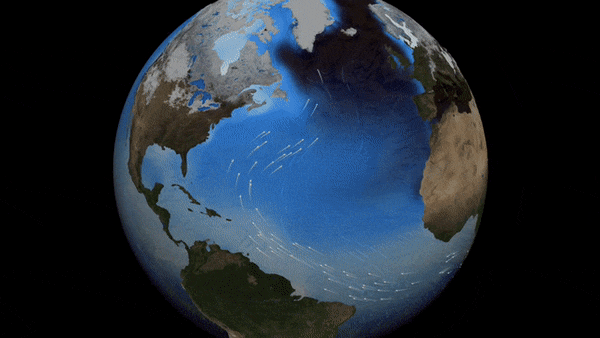
Atlantic ocean current collapse ahead
We don’t often see a scientific paper that uses the word warning in its title. But a new paper published July 25, 2023, in the prestigious journal Nature does use that word. It describes an imminent collapse of a key system of ocean currents, due to global warming. The paper is titled Warning of a forthcoming collapse of the Atlantic Meridional Overturning Circulation.
And, this paper says, the collapse could come as early as 2025.
The ocean currents of the Atlantic Meridional Overturning Circulation, aka the AMOC, help transport heat around the globe. So they are a key factor in a wide variety of weather and climate conditions.
A collapse of this system of currents could cause a precipitous drop in temperatures in Europe, including Scandinavia. It could raise sea level on the U.S. East Coast. And it could disrupt rainfall that billions of people depend on for food in India, South America and West Africa.
The new calculations come from scientists at the University of Copenhagen. Peter Ditlevsen of the university’s Niels Bohr Institute led the study, and he told The Guardian:
I think we should be very worried. This would be a very, very large change. The AMOC has not been shut off for 12,000 years [editors’ note: since the last Ice Age].
And Ditlevsen told Newsweek:
It was a surprise that it was found to be this early – at odds with what IPCC CMIP6 climate models predict [editors’ note: the IPCC models had predicted the collapse for the 22nd century].
What would happen?
The shutdown could come as early as 2025, these scientists found, or as late as 2095, with the greatest probability occurring around the year 2057 if current greenhouse gas emissions persist.
These new results contradict the latest report from the IPCC, which suggested the AMOC would not shut down until sometime in the 22nd century.
As always, not everyone agrees on the exact timing. But there has been evidence prior to this that the currents in the AMOC system are vulnerable to climate change. And there’s widespread acknowledgement that a change in these currents would change Earth’s weather.
David Thornalley at University College London told The Guardian that the study had large caveats and unknowns. He said further research was essential. But, he said:
If the statistics are robust and a relevant way to describe how the actual AMOC behaves, then this is a very concerning result.
Stefan Rahmstorf at the University of Potsdam, Germany, added:
There is still large uncertainty where the AMOC tipping point is. But the new study adds to the evidence that it is much closer than we thought. A single study provides limited evidence, but when multiple approaches have led to similar conclusions this must be taken very seriously, especially when we’re talking about a risk that we really want to rule out with 99.9% certainty.
Now we can’t even rule out crossing the tipping point in the next decade or two.

How do they know?
The new research came from two scientists – a physicist and a mathematician – who used advanced statistical tools and ocean temperature data from the last 150 years to study the ocean currents. A July 25, 2023, statement from the University of Copenhagen explained:
The researchers calculated that the ocean current, known as the thermohaline circulation or the Atlantic Meridional Overturning Circulation (AMOC), will collapse – with 95% certainty – between 2025 and 2095.
This will most likely occur in 34 years, in 2057, and could result in major challenges, particularly warming in the tropics and increased storminess in the North Atlantic region.
The lead author Peter Ditlevsen added:
While a cooling of Europe may seem less severe as the globe as a whole becomes warmer and heat waves occur more frequently, this shutdown will contribute to an increased warming of the tropics, where rising temperatures have already given rise to challenging living conditions.
He added:
Our result underscores the importance of reducing global greenhouse gas emissions as soon as possible.
Early warning signals
The researchers’ prediction relies on observations of what they called “early warning signals” that ocean currents exhibit as they become unstable. These early warning signals for the thermohaline circulation had been reported previously.
But, according to these scientists, it’s only now become possible to predict when a collapse will occur, thanks to the development of advanced statistical methods. Susanne Ditlevsen of the University of Copenhagen’s Department of Mathematical Sciences – the new study’s co-author – said:
Using new and improved statistical tools, we’ve made calculations that provide a more robust estimate of when a collapse of the [AMOC] is most likely to occur. This is something we had not been able to do before.
They said the thermohaline circulation has operated in its present mode since the last Ice Age, which ended approximately 11,000 years ago. During that Ice Age, the circulation of these ocean currents did indeed collapse:
Abrupt climate jumps between the present state of the AMOC and the collapsed state has been observed to happen 25 times in connection with ice-age climate. These are the famed Dansgaard-Oeschger events, first observed in ice cores from the Greenlandic ice sheet.
At those events climate changes were extreme with 10- to 15-degree C (18-27 degree F) changes over a decade. Meanwhile, the present day’s climate change is 1.5-degrees C (1.7 degree F) warming over a century.

Bottom line: Climate is complicated. And today scientists are speaking of an Atlantic Ocean current collapse that could dramatically change Earth’s weather.
Source: Warning of a forthcoming collapse of the Atlantic meridional overturning circulation











